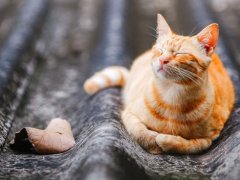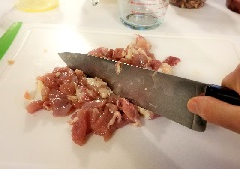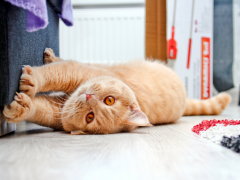
IvanZivkovic / Shutterstock.com
Since March 2024, when a bird flu virus (H5N1) outbreak occurred in dairy cattle in the United States, dozens of domestic cats and wild cats, including some in sanctuaries and zoos, have died from the virus. According to the American Veterinary Medical Association, cats seem to be susceptible to severe illness from bird flu, often resulting in death.
Here’s what you need to know about bird flu to keep your cat safe.
Bird Flu and Cats in the News
A number of cases of bird flu in cats were reported in the United States in December 2024, including the following:
The Santa Barbara County Public Health Department confirmed two cases of H5 bird flu in domestic cats. According to the Santa Barbara Independent, the pet cats contracted bird flu after being fed raw milk, eggs, and chicken. Both cats, as well as two others from the household, died from their illness.
Two cats in Los Angeles died after drinking recalled raw milk. The Los Angeles County Department of Public Health confirmed H5 avian flu in the cats, and is also investigating cases in other pet cats in the county.
About 20 big cats at a Washington wildlife sanctuary called the Wild Felid Advocacy Center of Washington died from bird flu between November and December, and an outbreak at an Arizona zoo killed several animals, including a cheetah and a mountain lion.
Also in December, Portland-based Northwest Naturals pet food company in December issued a voluntary recall of one batch of its 2-pound Feline Turkey Recipe raw frozen pet food. The recall came after a house cat in Oregon died after eating the food, which later tested positive for bird flu (H5N1). Read more about the Northwest Naturals recall here.
In January, both the U.S. Department of Agriculture (USDA) and the Federal Drug Administration (FDA) announced policy changes in response to the cases of bird flu linked to raw pet food and raw milk.
Bird Flu Risk to Humans
During the 2024 outbreak, there have been 66 confirmed reported human cases of bird flu in the United States. However, the Centers for Disease Control and Prevention (CDC) said that the current public health risk remains low. The majority of human infections have been traced back to exposures from commercial agriculture operations, such as dairy cattle herds and poultry farms.
How to Keep Cats Safe from Bird Flu
Bird flu is present in wild birds, poultry, and dairy cattle. To prevent bird flu transmission to cats, AVMA recommends pet owners to avoid feeding raw meat-based food and treats, as well as raw milk and other raw dairy products. Cats can also become infected with bird flu through exposure to infected wild birds, poultry, or exposure to the clothing of people who work on affected farms.
Keep cats indoors, away from wildlife, livestock, poultry, and their environments, and contact your veterinarian right away if you think your cat might have been exposed to the H5N1 bird flu virus.
“Although the risk of avian influenza is still considered fairly low, we do know that cats are susceptible to the virus and reported cases in cats are on the rise, so I would urge all cat owners to be alert and to consider taking sensible precautions to reduce risk of infection,†said veterinarian Dr. Lizzie Youens BSc (Hons) BVSc MRCVS. “Cats that are fed a raw diet are at higher risk of food-borne infections from bacteria and viruses, with unpasteurized (raw) milk and raw or improperly cooked meat known to be potential sources of bird flu infection for cats.â€
Dr. Youens said a sensible precaution to reduce the risk of contracting bird flu is for cat owners to avoid feeding raw dietary products and instead feed a cooked, nutritionally complete diet for cats.
The AVMA offers these tips to prevent H5N1 infection in pet cats:
- Do not feed cats any raw dairy products or colostrum.
- Thoroughly cook meat before feeding it to cats.
- Do not feed raw meat-based diets or treats.
- Keep cats indoors to prevent exposure to birds and other wildlife.
- Avoid contact with sick or dead birds and other wildlife yourself.
- Keep cats away from livestock, poultry, and their environments, especially in areas with known H5N1 outbreaks.
- Thoroughly wash your hands after handling your cat and after any encounters with poultry, livestock, or wild birds and other animals.
- Change your clothes and shoes, and thoroughly wash any exposed skin, after interacting with sick or dead animals that might harbor the H5N1 virus, and before interacting with your cat.
- Immediately contact your veterinarian if you notice signs of H5N1 or think your cat might have been exposed to the virus.
Signs of Bird Flu in Cats
Early signs of bird flu in cats can look much like many other illnesses: appetite loss, reduced energy, and fever. However, cats sick with bird flu can quickly become worse. The AVMA shares these signs of bird flu in cats:
- Neurologic signs, such as incoordination, circling, tremors, seizures, or blindness
- Severe depression (little to no interest in doing anything)
- Large amounts of discharge from the eyes and nose
- Other respiratory signs, including fast breathing, difficulty breathing, and possibly sneezing or coughing
Although the risk of a cat spreading the H5N1 virus to humans is extremely low, it is possible for infected cats to transmit the virus to people. If you think your was has been exposed or might be sick with the virus, consult with your veterinarian and your human physician on the next steps to take.








Thank you for your professional and clear presentation…very much appreciated!
I find your letters very helpful